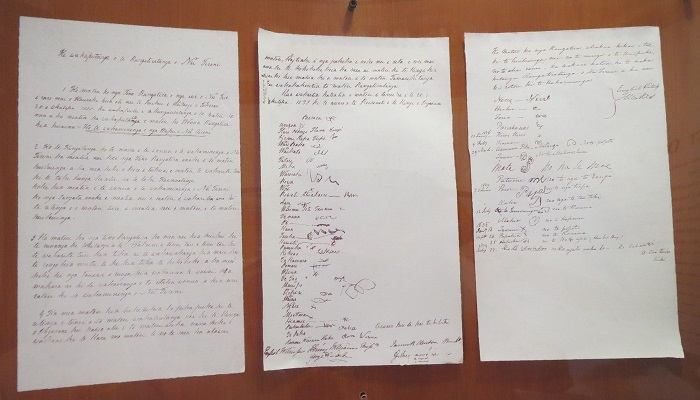Declaration of Independence (New Zealand)
Where can I find information about He Whakaputanga o te Rangatiratanga – The Declaration of Independence?
(Years 11-13)

Image: Declaration of Independence of New Zealand / He Wakeputanga [sic] o te Rangatiratanga o Nu Tirene by Sheila Thompson on Flickr.
Entry last updated: 2/10/25
Introduction
He Whakaputanga o te Rangatiratanga – The Declaration of Independence was signed on 28 October 1835 by 34 northern Māori chiefs. The document declared the independence of Nu Tirene (New Zealand) under the rule of the United Tribes of New Zealand, also called the Confederation of United Tribes.
The signing of the Declaration
James Busby along with Henry Williams and William Colenso drafted the declaration. Māori had no say in the document. James Busby then called a hui (meeting) at Waitangi for Māori chiefs to sign the Declaration.
The Declaration of Independence was closely followed by the Treaty of Waitangi in 1840.
This is a good website to get a first hand understanding on what the Declaration was about and what it meant for Māori.
Enter ‘Declaration of Independence’ in the search box.
Select the box for 'declaration of independence.'
The article He Whakaputanga - Declaration of Independence lists some of the reasons why the Declaration was signed, reactions, interpretations and how it was put into practice.
From here check out the image for He Whakaputanga document for an image of the Declaration which includes transcripts of the Māori and English versions.
Check out the related article Treaty timeline for events leading up the Declaration of Independence and the Treaty of Waitangi.
Tips: Search words, or keywords, are the most important words in our question. We can always change our keywords or add more if we need to.
Te Ara: The Encyclopedia of New Zealand
Te Ara is an excellent starting point for all questions about Aotearoa New Zealand. If we look down to the bottom of the page, we can see that the website belongs to the Ministry for Culture & Heritage, so the information is well-researched and reliable.
Search for 'He Whakaputanga' or 'Declaration of Independence',
Choose the link to He Whakaputanga - Declaration of Independence.
This story leads to information on the background of the Declaration, it’s contents and the aftermath.
Tips: ‘External links and sources’ that appears at the end of most articles on Te Ara is always a good way to explore related material on your topic.
This government ministry leads New Zealand on matters of justice. It’s website has links to important documents such as The Declaration and the Treaty of Waitangi.
This is the official website of the Waitangi Tribunal. There is lots of information here about how the Tribunal works and how it interacts with the Treaty of Waitangi.
Go to Publications and then Tribunal Reports.
Look down the list to Wai 1040.
Select He Whakaputanga me to Tiriti/The Declration and the Treaty: The Report on Stage 1 of the Te Paparahi o te Raki Inquiry.
Read Chapter 4 He Whakaputanga and the Declaration of Independence.
Chapters 6 and 7 explain The British move towards annexation and The Negotiation and signing of Te Tiriti.
Tips: We like sites like this because they’re reliable. You can tell because of their web address – they have either .govt or .ac, meaning they are from government or educational organisations. They’re also New Zealand sites, so relevant for us.
Treaty of Waitangi Collection (BWB)
This is a collection from Bridget Williams Books (BWB) that is part of the EPIC databases. It has digitised books about the Treaty of Waitangi.
Look for He Whakaputanga/The Declaration of Independence, 1835 which showcases the history of the document, images of the document, and the signatories.
Select Read Now to read the book, or choose a chapter from the Contents.
Or go to An illustrated history of the Treaty of Waitangi and read Chapter 1: An independent land - New Zealand to 1840. This chapter covers the history of New Zealand leading up to the Declaration of Independence.
Tips: To get to the EPIC resources you will need a password from your school librarian first. Or you can chat with one of our AnyQuestions librarians and they will help you online. Some EPIC databases may also be available through your public library.
What the Declaration achieved
Over the years there have been discussions and interpretations on what the declaration actually achieved for Māori, and whether or not sovereignty was handed over as a result of the later signing of the Treaty of Waitangi.
Te Rua Mahara o te Kāwanatanga | Archives New Zealanda
Guardians of New Zealand’s public archives, this government agency ensures that records of value are available to the public.
Go to the tab Discover our stories and select The Declaration of the Independence of New Zealand.
This has a short history of the document, as well as the original Te reo Māori text and English translation.
Look down to the end of the page and explore the links.
This website publishes monthly reviews of law affecting Māori. Reviews have been catalogued according to issues. There are two interesting reviews about the Declaration of Independence in light of the Treaty of Waitangi.
Select Previous Issues from the menu on the right hand side of the page.
Find the November 2014 issue to read Waitangi Tribunal finds Treaty of Waitangi signatories did not cede sovereignty in February 1840 and He Whakaputanga me te Tiriti: the Declaration and the Treaty - sovereignty in February 1840 - comment.
Tips: Websites that have .com or .co in the address can have good information, but you need to assess how reliable it is. Check the About us link on the website, if you can find one. That can tell you what the company’s mission and values are.
Memory of the World Aotearoa New Zealand Ngā Mahara o te Ao
UNESCO launched the Memory of the World programme in 1992. This site is part of the New Zealand Memory of the World Programme. It’s vision is to protect, preserve, recognise and make available heritage documents to the world.
Go to New Zealand Register and enter 'He Whakaputanga' or 'Declaration of Independence' into the search box.
You will find a link to He Whakaputanga o te Rangatiratanga o Nu Tireni .
Here you will find who signed the Declaration and who officially recognised this document when it was first signed.
Tips: Websites that have .org or .net in the address can have good information, but you need to assess how reliable it is. Check the About us link on the website, if you can find one. That can tell you what the organisation’s mission and values are.
The Declaration today
There continues to be some debate about what the Declaration means for Aotearoa New Zealand now, and what it will mean in the future.
New Zealand Geographic Online is a part of EPIC, a collection of reliable databases covering lots of different topics. It’s put together especially for New Zealand school students and helps to answer questions like this.
Enter the words ‘Declaration of Independence’ into the search.
Select the article A Sovereign Act .
This article is based on Ngāpuhi’s view on whether or not sovereignty was surrendered by Māori in the Treaty of Waitangi, and if the Declaration was more important.
Tips: To get to the EPIC resources you will need a password from your school librarian first. Or you can chat with one of our AnyQuestions librarians and they will help you online. Some EPIC databases may also be available through your public library.
He Tohu meaning ‘the signs’ is a permanent exhibition of three iconic documents that shaped New Zealand. The exhibition has been created in partnership between the Crown and Māori. Students can visit the exhibition in person but there is also information available online.
Look for the heading The story of the documents and choose 1835 He Whakaputanga.
Find out about who signed He Whakautanga and who came up with the words.
Tips: A website’s address (URL) can give you a hint about how reliable it is. Look for addresses in the results that include .govt or .edu in the URL. These are quality sites from national or overseas government or educational organisations.
This is an online Sunday magazine about expressing Māori and Pacific views in New Zealand media.
Find the search box and use the search words 'He Whakaputanga.'
Read articles Without He Whakaputanga, there might have been no Treaty of Waitangi and He Whakaputanga: Partnership and power sharing.
Tips: Some websites have requests for financial contributions. It’s best to ignore these requests and focus on the information we’re looking for.
Books
There are only a few books written for students on He Whakaputanga o te Rangatiratanga o Nu Tireni – Declaration of Independence, as most books focus on the Treaty of Waitangi.
Here are two recommended books - check out your local public or school library to see what they have.
Two worlds meet by Tamsin Hanly.
Treaty: a legal nullity by John Hatini.
SCIS no: 1832260
Topics covered
Related content

Treaty of Waitangi
Where can I find information about the Treaty of Waitangi - Te Tiriti o Waitangi?

Māori history
Where can I find information about Māori history?

He Whakaputanga 1835
Discover resources related to He Whakaputanga | Declaration of Independence.

History (New Zealand)
Where can I find information about New Zealand history?

Waitangi Tribunal
Discover resources related to the Waitangi Tribunal.
